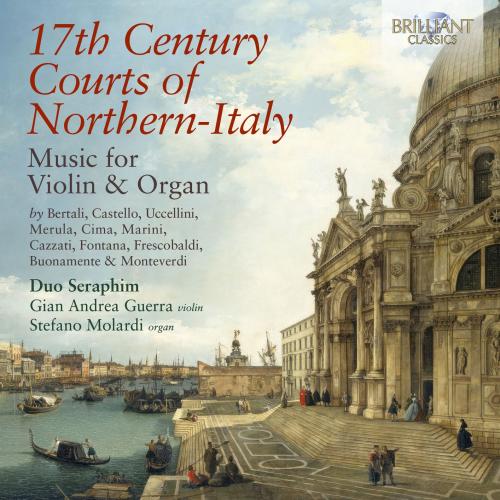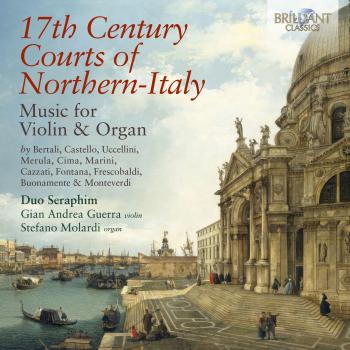
17th Century Courts of Northern-Italy Music for Violin & Organ Duo Seraphim
Album info
Album-Release:
2024
HRA-Release:
25.10.2024
Label: Brilliant Classics
Genre: Classical
Subgenre: Chamber Music
Artist: Duo Seraphim
Composer: Antonio Bertali (1605-1669), Dario Castello (1600-1658), Marco Uccellini (1610-1680), Tarquinio Merula (1590-1665), Giovanni Paolo Cima (1570-1630), Biagio Marini (1597-1665), Maurizio Cazzati (1620-1677), Giovanni Battista Fontana (1571-1631), Girolamo Frescobaldi (1583-1643), Giovanni Battista Buonamente (1595-1642), Claudio Monteverdi (1567-1643)
Album including Album cover Booklet (PDF)
- Antonio Bertali (1605 - 1669): Ciacona:
- 1 Bertali: Ciacona 09:17
- Dario Castello (1602 - 1631): Sonata seconda:
- 2 Castello: Sonata seconda 06:04
- Marco Uccellini (1603 - 1680): Sonata prima:
- 3 Uccellini: Sonata prima 07:37
- Tarquinio Merula (1595 - 1665): Canzone quinta:
- 4 Merula: Canzone quinta 07:37
- Giovanni Paolo Cima (1570 - 1622): Sonata a violino solo:
- 5 Cima: Sonata a violino solo 05:43
- Biagio Marini (1594 - 1663): Sonata variata, Op. 8:
- 6 Marini: Sonata variata, Op. 8 08:28
- Maurizio Cazzati (1616 - 1678): Sonata prima "la pellicana":
- 7 Cazzati: Sonata prima "la pellicana" 04:14
- Giovanni Battista Fontana (1589 - 1630): Sonata seconda:
- 8 Fontana: Sonata seconda 07:32
- Girolamo Frescobaldi (1583 - 1643): Toccata decima:
- 9 Frescobaldi: Toccata decima 05:53
- Giovanni Battista Buonamente: Ballo del granduca:
- 10 Buonamente: Ballo del granduca 08:02
- Claudio Monteverdi (1567 - 1643): Jubilet:
- 11 Monteverdi: Jubilet 05:26
- Duo Seraphim:
- 12 Monteverdi: Duo Seraphim 06:10
Info for 17th Century Courts of Northern-Italy Music for Violin & Organ
The Northern Italian courts along the Po Valley-Mantua, Milan, Cremona, Ferrara, Parma, Modena and Bologna, plus Venice as a sort of ‘honoris causa Padanian’ court – were the epicentre in the first decades of the 17th century for the development of new forms, new styles and new performance techniques in the sphere of instrumental music.
Among the protagonists of this phase were the composers featured on this programme, and the burgeoning interest in this ‘new music’ at an international level attracted some of them away to other European centres – Vienna (Bertali and Buonamente), Warsaw (Merula), Neuburg and Düsseldorf (Marini) and Prague (Buonamente again) – leading to a consolidation through these composers’ works for violin and continuo of a success story for Italian music that had begun in the previous century with the madrigal.
The modern listener is struck by the development of refined instrumental techniques and the variety of forms.
With respect to technique, Manfred Bukofzer in Music in the Baroque Era, from Monteverdi to Bach (1947) noted how ‘the virtuoso character of the violin sonata made itself felt not only in the fiery scale passages, the wide skips and the use of high positions, rarely used in ensemble music, but especially in the astonishing transfer of vocal idioms to the violin.’ Nevertheless, the music ‘retained an essentially instrumental style by virtue of the continuous rhythm of the solo passages, upbeat patterns, idiomatic figurations and such violinistic features as double and triple stops, pizzicato, col legno, and the use of harmonics.’
Regarding form, ‘The earliest stage of the sonata is represented by numerous works that progress from beginning to end without interruption and are subdivided only by changes of meter, tempo or thematic material… In the violin literature of the early 17th century… there are many sonatas of this type’ (Willi Apel, Italian Violin Music of the 17th Century, 1990).
Marini’s Sonata variata is one. On the other hand, compositions that refer to traditional melodies, both from the vocal and instrumental repertoire, are Variation forms. In the Uccellini, as in Buonamente’s Ballo del Granduca, Guerra and Molardi realize the original ‘a tre’ writing on two instruments only: the organ, in addition to realizing the bass, plays one of the melodic parts.
A similar choice is adopted in their transcription of Monteverdi’s Jubilet: the melodic part conceived for voice is mainly entrusted to the violin, which enriches it with ornamentations, while the organ plays the recitative sections, also with added embellishments.
Duo Seraphim
Gian Andrea Guerra, violin
Stefano Molardi, organ
Duo Seraphim
Britta Hauenschild and Andreas Düker have been working together on music in a variety of ensembles for almost 20 years. Since 2010 they comprise DUO SERAPHIM, performing music that is especially close to their hearts: music of the Renaissance. An understanding of historical performance practices is just as important to the duo as playing inspired, passionate and melodious music together.
Britta Hauenschild
studied the modern concert flute at the University of Music Detmold / Münster (Germany). Afterwards she specialized in playing historical flutes while studying at the Academy of Early Music in Bremen (Germany) under Professor Marten Root. Numerous master classes, including classes under Paul Meisen, Robert Aitken and Barthold Kuijken, extended her education in modern and historical flutes. Today she feels just as at home on the classical multi-keyed flute as she does on the baroque transverse flute. However, her very special love is for the clear, rich tonal colour and fine sound of the Renaissance flute, and for the literature of the era. She is a member of numerous chamber music ensembles. Moreover, she participates in CD, radio and television productions and is highly in demand as a flutist for a variety of ensembles and orchestras.
Andreas Düker
studied classical guitar in Kassel (Germany) under Wolfgang Lendle. He graduated as an artist specializing in the lute in 1996 under Professor Stephen Stubbs at the University of the Arts in Bremen (Germany). He has participated in numerous master classes, including under Frank Bungarten, Paul O‘Dette and Hopkinson Smith. In addition to the Renaissance lute, he has mastered the chitarrone, vihuela, baroque lute and baroque guitar. He also interprets guitar music from the classical and early Romantic periods on instruments of the era. His concert performances include participation in various operas in Germany and other parts of the world, as well as numerous performances both as a soloist and in ensembles. He received an honourable mention in the international “Musica Antiqua” competition in Brügge in 1996 as the best lutenist. He participates in the production of CDs and broadcast productions and performs at a wide variety of festivals.
Booklet for 17th Century Courts of Northern-Italy Music for Violin & Organ










